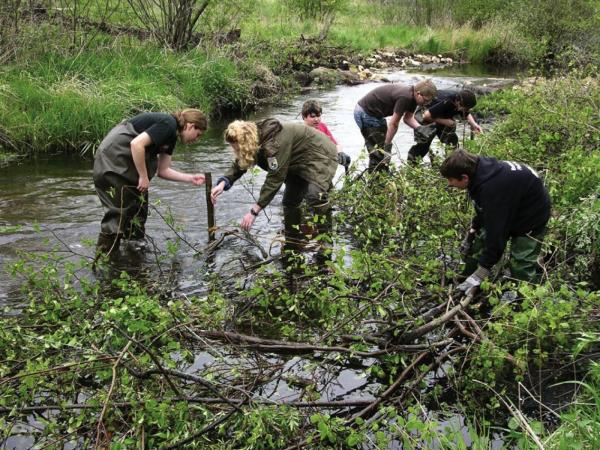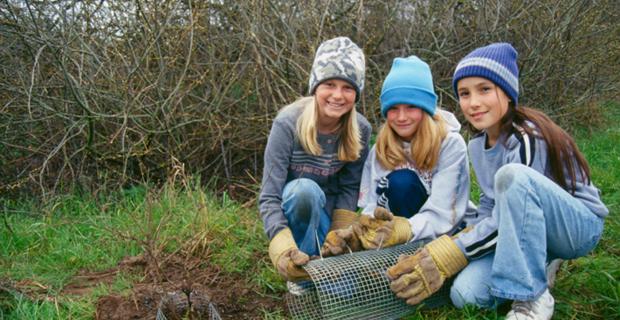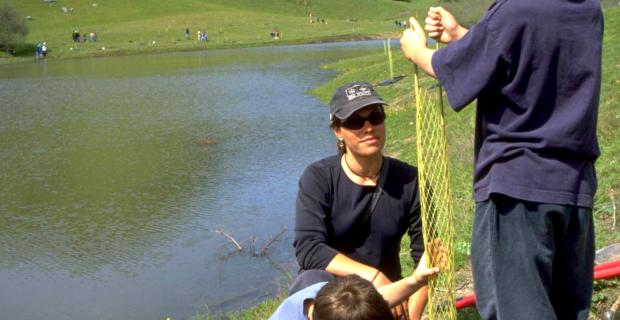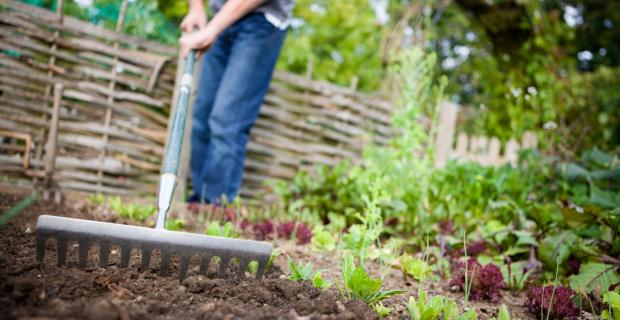River Crossing Environmental Charter School

In 2001, when Victoria Rydberg applied for a teaching job at River Crossing Environmental Charter School, she didn't know much — or feel particularly passionate — about the environment.
She was twenty years old and six months out of college, with a degree in literature. But she needed a job and believed she was a good teacher, and she persuaded administrators to take a chance on her. The idea for River Crossing, a new school in Portage, Wisconsin, about 40 miles north of Madison, came from an administrator who hoped that using the environment as a learning context would help middle school students become more interested in learning and more successful at taking tests. Eighteen students enrolled in the program, housed in a two-room trailer erected behind the public school. Rydberg would be their only teacher, with a mandate to teach everything through an environmental framework.
By any sensible standard, it looked like a setup for disaster. In fact, it took only a month for Rydberg to realize that she had gotten in way over her head. She taught basic recycling and water conservation — but not the ecology behind it, which she lacked—and her students went into the field to do weekly habitat restorations with Jeff Nania, executive director of the Wisconsin Waterfowl Association. They found their field experiences completely exhilarating — and totally disconnected from what they did in the classroom.
"I realized I had to do something to make it different, so I started learning right along with the kids," Rydberg recalls. "In the field, they asked questions like, 'What flower is this? What grass is this?' And I said, 'I don't know. Let's look it up.'" While the truth was that she didn't have the answers herself, the experience shaped Rydberg's subsequent mission: to help River Crossing students become resourceful learners about the natural world. Rydberg and Nania also soon realized that everything students did in the field would have to be integrated into the classroom and the study of ecology.
What ultimately sold Rydberg on using the environment as a context for learning was more personal: "In our first year, 40 percent of the kids were identified as at-risk. And all of a sudden, I watched these kids who were getting Ds and Fs gain two to three reading levels because they liked what they were reading. Seeing their success made me realize how amazing using the environment for learning can be."
In 1998, the State Education and Environment Roundtable (SEER), a cooperative endeavor of sixteen state departments of education, issued a report that concluded, "Students learn more effectively within an environment-based context than within a traditional educational framework." It found that using this context significantly improves student performance in reading, writing, math, science, and social studies, and enriches the overall school experience. These findings were reaffirmed in a 2005 SEER report, which stated, "These engaging programs appear to better connect students to their learning by allowing them to take a more active role in their studies."
On-the-Job Training
River Crossing is one of 135 schools that belong to the recently formed Green Charter Schools Network. Its president, Jim McGrath, the retired principal of a charter school in Oshkosh, Wisconsin, notes that the network takes advantage of the relative freedom that charter schools provide teachers, but its ultimate goal is to inspire more schooling for sustainability in all public schools.
"We're all concerned about the environment and sustainability," says McGrath, who has spent more than thirty years working in public schools. "That's why we're doing it — because, really, what could be more important than preparing young people for a sustainable future?"
Seven years after she began teaching at River Crossing, Rydberg still looks as if she is fresh out of college. But now she holds a master's degree in environmental education and has been named Environmental Educator of the Year by the Wisconsin Association for Environmental Education. Her students work closely with such organizations as the Aldo Leopold Foundation, the International Crane Foundation, and the Department of Natural Resources. Rydberg has identified seven critical elements for learning through an environmental framework: environmental conservation integrated throughout the curriculum; a positive learning community; hands-on learning and self-directed discovery; projects and activities focused on "real-world" and life skills; leadership opportunities for students; constructed challenges for personal and academic growth; and interaction with professionals in the classroom, community, and field.
On a snowy day in 2008, Rydberg and a half-dozen current and former students gathered at the nearby Leopold Foundation. Housed on the property where Leopold lived and wrote A Sand County Almanac, the foundation promotes the work of the writer and educator widely considered the father of wildlife management.
Executive director Buddy Huffaker asked Rydberg in 2007 if her class would like to become involved in the foundation by planting a rain garden on the property. She presented the proposal to her students, believing they would need to be interested for it to become a meaningful education experience.
"What's a rain garden?" they asked.
"Let's look it up," Rydberg responded. Her students explored how rain gardens function and why they're needed; which plants can thrive; and how they reduce pollution in creeks and streams by absorbing rainwater from roofs and other water-resistant surfaces instead of allowing it to flow into storm drains. Their research lasted several months and enabled them eventually to design their own rain garden, dig the trenches, direct the bulldozers, and reconcile competing opinions along the way.
Project-based Learning
To prepare students for projects that will contribute to sustainable communities, Rydberg begins by focusing on school as a place of cooperation rather than competition. "I try to break down the idea that there are smart kids and dumb kids, and we work on team building so kids can start to understand that they need to be able to learn from each other," she says. "We look at multiple intelligences and how everyone brings something to the table. Then we start to do a lot of problem-solving projects."
After spending about two months focused on cooperation and problem solving, Rydberg turns to helping students see themselves as active participants in their community. They begin each day by reading the newspaper, identifying issues that can serve as springboards for future projects. While reading the news one day, Rydberg's class became interested in a local mayoral contest. They wanted to learn more about the candidates' positions on the environment, so they hosted a debate and invited the candidates, all of whom came.
On another day, students read that the Department of Natural Resources planned to cut funding for an environmental stewardship fund. "As a class, we started to take an interest in this and say, 'Hey, this is wrong,'" recalls former student Brock Reeson. "We all just came to a decision to try to do our best to sway these people's decisions. We wrote letters to the finance committee stating why we believed that was bad, and the governor finally vetoed the bill. We were invited to go to Madison, and I got to stand right behind him and watch him veto it."
While River Crossing students are clearly most excited about their hands-on projects, they must still master classroom learning, but even this is grounded in their immediate environment. In history class, for example, River Crossing students explore the ecological and human history of their region, which was home not only to Leopold, but also to other environmental pioneers, including John Muir and Senator Gaylord Nelson, who inspired several important pieces of environmental legislation and the founding of Earth Day.
River Crossing students also read Leopold's A Sand County Almanac twice every year. "They're so interested in the content and lessons," says Rydberg, "that we can sit together and pick it apart. They come to understand it better than a lot of adults I've met in the environmental world."
History, literature, and science provide many natural avenues for introducing environmental and ecological concepts, but math initially proved a little more challenging. Rydberg applied for a grant from the Wisconsin Department of Public Instruction Charter School Program, which enabled her to oversee the development of a new math curriculum, with units on everything from prairies to gardening and freshwater systems.
For example, a unit on birds challenged students to apply their knowledge of geometry to explore how the weight of a feather affects a bird's flight, and how to calculate the ratio of primary to secondary feathers. "It lets them learn math in a context that seems relevant to them," says Rydberg, "and makes sure they learn what they need to know for the tests."
This leads, of course, to the big question: How can River Crossing students spend their time building rain gardens, quizzing mayoral candidates, and lobbying against environmental budget cuts — and still pass No Child Left Behind tests?
"I never focus on teaching to the test. I think it is the most stressful day of the whole year. And, if I could throw out all grades, I would do that," says Rydberg. "Grades don't show what these students are learning; the projects do." In an attempt to have students demonstrate that knowledge, she requires them to present a portfolio of the year's work to parents and other community members in the last month of school.
Still, like all public school students, River Crossing youth must eventually sit down and take the required tests. And when they do, they perform remarkably well. Compared to students at Portage Junior High and to the Wisconsin state average for eighth-grade students, they have fared as well or better in all subjects — including eighth-grade reading, math, science, and social studies — since the school opened.
This essay was adapted from the book Smart by Nature (Watershed Media/University of California Press, 2009).
References: "The Effects of Environment-Based Education on Student Achievement," State Education and Environment Roundtable, 2005, p. 6, http://www.seer.org/pages/research/CSAPII2005.pdf.
Lieberman, Gerald A. and Linda L. Hoody, "Closing the Achievement Gap: Using the Environment as an Integrating Context for Learning," The State Education and Environment Roundtable, 1998, p. 2, http://www.seer.org/extras/execsum.pdf.




